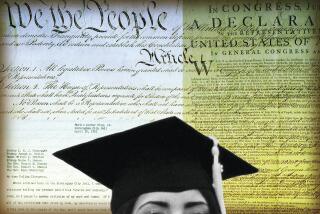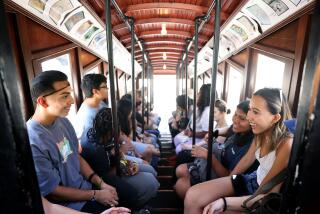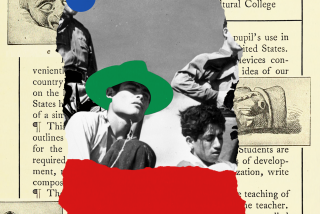Centerpiece : Patriots of a...
Ask him about the stripes on the flag. Or the chief justice of the Supreme Court. Or the number of articles and amendments that make up the Constitution. Bill Morgan could go on about them for hours, and has, before grateful audiences.
For 27 years, Morgan has been teaching American government to immigrants seeking U.S. citizenship. In a spare Oxnard High School classroom, he leads his charges through nine weekly sessions, then packs them off to face a federal Immigration and Naturalization Service test.
“I’ve had five people fail. And that’s out of more than 1,000,” says Morgan, 72. “When they get through, they really do know more about the country than people born and raised here.”
They know about Washington and Lincoln; about the flag’s 13 stripes symbolizing the original 13 Colonies; about Chief Justice William H. Rehnquist; about those seven articles and 26 amendments of the Constitution. Many of Morgan’s students have also heard about how Theodore Roosevelt, on his way to a 1912 campaign event, was shot by a would-be assassin. Undaunted, Roosevelt kept his appointment and spoke for an hour with the bullet in his chest.
That last piece of history hasn’t come up in an INS test yet, Morgan acknowledges, but the students always seem to enjoy it.
“They’re also impressed with Franklin Delano Roosevelt,” says Morgan, “because he was elected four times.”
Morgan’s own incumbency began in 1964. By then, he was already 17 years into a teaching career, leading physical education classes at Haydock School in Oxnard. When a colleague needed a substitute for a night pre-citizenship class, Morgan took over.
“And loved it,” he says. “They were so appreciative. I thought, “My God, they’re here because they want to be.’ ”
Through the years, the largest number of students in his classes have been Mexican immigrants. But the classes have also included numerous Filipinos--many of them wives of Navy men stationed at Port Hueneme--and Southeast Asians. Other students have been Irish, English, Arabian, Nepalese, Maltese, Latvian and Russian. After each class session, most of the students pause on their way out to thank their teacher, shake his hand and say good night.
In 27 years, Morgan says, he can’t recall a serious classroom confrontation, either between him and a student or between two students.
Instead, he recalls the Czechoslovak who was amazed that he could travel to San Francisco without having to inform government agencies in advance. Then there was the student who arrived at class angry, because he had heard a neighbor idly complain about a burned-out street light.
Morgan remembers the student saying: “ ‘Where I come from, you didn’t go out at night without a lantern, because you’d fall in a hole. There were no street lights.’ ”
The test that awaits the immigrants is brief but vital. Generally, says Morgan, an INS official hands over a form containing 20 questions. The official instructs the applicant to answer question 1 out loud, then question 7, question 3 and so on, bouncing around the page.
Fourteen correct answers is passing. The most-often-asked questions, Morgan says, explore the checks-and-balances relationship among the executive, judicial and legislative branches of government.
Other favorites: Name the two U.S. senators from California. Name the principal author of the Declaration of Independence. How many members has the U.S. Senate? The House of Representatives?
Morgan retired from his daytime teaching job three years ago. But he held on to the government class, teaching four sessions a year from September to June.
Lately, he says, his wife has suggested that he consider full retirement. But Morgan will have none of that, and the $20-an-hour paycheck from the Oxnard Adult Education Program doesn’t have much to do with it.
“These people are better Americans than most of us. They really are,” he says. “They see the good things.”
More to Read
Sign up for Essential California
The most important California stories and recommendations in your inbox every morning.
You may occasionally receive promotional content from the Los Angeles Times.










